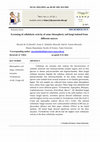Papers by Mostafa El-sheekh

Egyptian Journal of Aquatic Biology and Fisheries, Oct 31, 2023
Lotic ecosystem monitoring is important to avoid pollution risks, safeguard biodiversity, and mai... more Lotic ecosystem monitoring is important to avoid pollution risks, safeguard biodiversity, and maintain ecosystem health. In this essence, it is impossible to ignore the involvement of epiphytic microalgae in riverine monitoring. Two host plants, such as the common reed, Phragmites australis, which is primarily found in marsh grasses, and the submerged, free-floating hornwort, Ceratophyllum demersum, were chosen for this study. The estimation of various biodiversity metrics, including Brillouin, Dominance (D), Equitability (J), Evenness (e^H/S), Margalef, Menhinick, Shannon (H), and Simpson (1-D), were conducted in Diyala River, Diyala province, Iraq, using data covering the four seasons. One hundred and forty-four taxa of epiphytic algae on both host plants were recorded. Among them, diatoms (Bacillariophyta) were the predominant group of algae on both plants comprising 84% and 92% of C. demersum and P. australis, respectively, followed by Cyanophyceae (3-25%) and Chlorophyceae (3-42%). Preferences of algae on particular host plants were observed. A spatial and temporal of epiphyton algae was observed on the plants. Some epiphyton species, such as Gomphonema paravalum, Ulnaria acus, Cyclotella meneghiniana, Navicula gregaria, and Nitzschia amphibian arerecorded in the river and are considered bioindicators for determining the water quality. By applying the recommended indices as mentioned in the text you have to recognize the trophic, saprobic, and halobic status of the investigated area based on the identified species. Based on the overall outputs of this study it is anticipated that the Diyala River is getting a pollution load; the level of pollution must be determined (betamesosaprobic, alpha mesosaprobic, polysaprobic) that needs to be overcome.

Brazilian Archives of Biology and Technology, Feb 1, 2014
In the present study, the effects of Spirulina on subchronic treatments (two weeks) of hyperlipid... more In the present study, the effects of Spirulina on subchronic treatments (two weeks) of hyperlipidemia and liver function of the rats and humans were investigated. The hyperlipidemia was induced in the rats using 25% of soya bean oil and 25% butter. The butter induced more hyperlipidemia than soya bean oil. Spirulina was used at the concentrations of 0, 2.5, 5.0 and 10 % of diet weight of the rats. The decrease in hyperlipidemia by Spirulina was dependent on its concentration in the diet. In case of human studies, about four g/day of Spirulina was taken via oral administration by Egyptian volunteers patients with hyperlipidemia. Spirulina decreased the levels of hyperlipidemia in these patients. The effects were dependent on the amount and number of administered dose of Sprirulina. The results suggested that the Spirulina treatment could induce marked reduction of aminotransferase through correcting lipid profile and increasing high density lipoprotein.

Biotechnology for biofuels and bioproducts, Feb 1, 2023
The work focuses on studying the solubility and stability of dissolved bioethanol as a fuel addit... more The work focuses on studying the solubility and stability of dissolved bioethanol as a fuel additive in different fuel blends of gasoline, diesel, 50% diesel/50% biodiesel. Dissolved ethanol fuel appears as particles with a unique size distribution inside the whole fuel blends, and its stability was measured in this work. Bioethanol dissolved fuel particles stability was improved after blending the bioethanol with 50% diesel/50% biodiesel than pure diesel or pure gasoline fuel alone. The obtained results reveal that the lowest bioethanol particles stability was obtained when commixed with gasoline and the suspended ethanol particles completely accumulated at different concentrations of bioethanol in the fuel blends of 2%, 4%, 6%, 8%, 10%, and 12% by volume after 1 h of mixing time. Furthermore, the measured data of the bioethanol particles size distribution reveals that the suspended stability in the diesel blend improve slightly for all bioethanol concentrations of 10%, 15%, 20%, 25%, and 30% by volume. While the bioethanol concentrations of 5% show acceptable particles stability and size distribution during the whole experiments time. Obtained results show that bioethanol suspended particles stability was enhanced for 50% diesel/50% biodiesel blend with different bioethanol concentrations of 5%, 10%, 15%, 20%, 25%, and 30% by volume basis. However, the size of the particles increased as the bioethanol concentration rose with the passage of time.

Arabian Journal of Geosciences, Sep 1, 2022
El-Mex Bay is a semi-sheltered coastal embayment located west of Alexandria, the Egyptian Mediter... more El-Mex Bay is a semi-sheltered coastal embayment located west of Alexandria, the Egyptian Mediterranean Sea. It is considered as a hot spot area receiving industrial, agricultural, and domestic wastes from the adjacent Lake Mariut through El-Umum Drain. To evaluate the water quality of the bay, phytoplankton and macroalgae as biological tools were investigated seasonally concerning physicochemical parameters from 2018 to 2019. The results indicated that the Bay harbored a diversified phytoplankton community (162 species), comprising 99 freshwater forms, 38 marine, 22 euryhaline, and only 3 brackish forms. The total average phytoplankton abundance was 419,414 unit/L. Few species were responsible for the main bulk of phytoplankton namely Merismopedia tenuissima, Cylindrotheca closterium, Cyclotella sp., Skeletonema costatum, Scenedesmus quadricauda, Scenedesmus bijugus, and Tetradesmus dimorphus. During the study period, El-Mex Bay was affected by the presence of 13 harmful and /or toxic algal species, among which the mediophyte species Skeletonema costatum was responsible for the peak occurring during autumn (2018). The results of the recorded nutrients indicated that the Bay is highly loaded, where NH 4, NO 2, NO 3 , PO 4 , and SiO 4 attained 141.68 µM, 25.61 µM, 151.16 µM, 10.73 µM, and 232.86 µM, respectively. The macroalgal flora was represented only by the two opportunistic species (Ulva fasciata and Ulva intestinalis). Both species could survive in freshwater conditions exhibiting very broad salinity tolerance (6.51-38.41‰) and a high level of nitrogenous compounds. Those results revealed that El-Mex Bay suffers from pollution and deterioration of water quality.

المجلة المصرية للبيولوجيا التجريبية. علم النبات, 2018
Chlorella vulgaris is a photosynthetic unicellular green eukaryotic alga. It is widely used as fo... more Chlorella vulgaris is a photosynthetic unicellular green eukaryotic alga. It is widely used as food additive and in the pharmaceutical and cosmetics industry. It contains proteins, carotenoids, lipids, immunostimulator compounds, polysaccharides, vitamins, antioxidants, and minerals. The present study was conducted to investigate five different synthetic media such as BG-11, Chu- 10, Bold’s Basal medium, Allen, and Kuhl’s medium on the optical density, cell count, chlorophyll-a content, protein content and carbohydrate content of Chlorella vulgaris. Kuhl’s medium had the best growth followed by Allen, BG-11, Bold’s Basal medium, and the Chu- 10 medium. The highest optical density, cell count, and chlorophyll- a content were obtained at pH 12 as compared with a control. NH4Cl was the best nitrogen source for Chlorella vulgaris which was cultivated in Kuhl’s medium as compared with KNO3 as a control. Aeration of algal culture and using sunlight as a light source increased growth and chlorophyll-a content over nonaerated culture using artificial light.

المجلة المصرية للبيولوجيا التجريبية. علم النبات, 2017
The processes of biodegradation have widely used to remove hazardous material from aquatic and so... more The processes of biodegradation have widely used to remove hazardous material from aquatic and soil system is an environmental friendly tool. The present study was conducted to investigate the decolorization and biodegradation of some dyes using some microalgal species isolated from pollutant industrial regions. Two microalgal species (cyanobacteria) were isolated and were identified as Pseudo anabaena sp. and Microcystis aeruginosa. The ability of the two algae to remove and decolorize Disp.orange 2RL, reactive yellow 3RN, Reactive black NN and Tracid red BS were investigated. The results revealed that the removal of these dyes depends on the algal species, its growth rate and the structure of dyes. The maximum decolorization was observed in Reactive black NN and Disp.orange 2RL by M. aeruginosa 55.12 % and 65.07 %, respectively after 7 days incubation. Also Pseudo anabaena sp. decolorized Reactive yellow 3RN and Tracid red BS by 58.47 % and 78.44%, respectively. Azo reductase enzyme of algae which responsible for degradation of azo dyes into aromatic amine by cleavage the azo linkage was estimated. The results showed that treatment of M. aeruginosa with Disp.orange 2RL induced the azo reductase enzyme by 68.04% and Pseudo anabaena sp. with Reactive yellow 3RN by 55.64 % after 7 days of incubation. The degradation product after decolorization was examined by spectroscopic analysis and Fourier transformed infrared spectroscopy analysis.

Elsevier eBooks, 2021
Abstract Nowadays, membrane bioreactor (MBR) technology has been used as an effective approach fo... more Abstract Nowadays, membrane bioreactor (MBR) technology has been used as an effective approach for wastewater treatment due to its benefits, such as the high quality of treated water and the durability of the system. This technology could be recommended to encourage the reuse of treated wastewater for so many purposes except for drinking water, such as toilet cleaning and irrigation purposes. Interestingly, MBR technologies are able to remove various types of viruses and phages. In addition, MBRs are widely applied in the removal of heavy metals, hydrocarbons, dye molecules in textile industry wastes, dangerous micropollutants such as phenolic compounds, phthalates, and estrogen, rare organic compounds such as surfactants, pharmaceutically active compounds, micropollutants, and hormones. Based on this, the current chapter emphasizes the approach of applying MBR technology for water treatment options and explains the different types of MBR systems, showing the hydrodynamic efficiency of these MBR systems. It will also give an insight into some problems such as dirt and nutrient removal. On application of membranes with conventional biological therapy, it is proved that MBR is a very promising technique and effective in microcontaminant removing compared to other conventional methods undertaken in most wastewater treatment plants. Currently, it is used in treating both municipal and industrial wastewaters. The MBR systems under anaerobic conditions are recently getting much attention as a potential solution of water reuse to secure fresh water for other purposes and a proposed source for renewable energy to help reduce greenhouse gas emissions.

Delta Journal of Science, Jul 1, 2022
Rhizospheric soil fungi, cellulolytic enzymes, Trichoderma viride, Congo red Cellulases are enzym... more Rhizospheric soil fungi, cellulolytic enzymes, Trichoderma viride, Congo red Cellulases are enzymes that catalyze the bioconversion of cellulose molecule into monosaccharides (simple sugers) such as beta glucose or shorter polysaccharides and oligosaccharides. Most fungal cellulase enzymes degrade the cellulose molecule and several other polysaccharides into monosaccharides. In this study, twenty fungal species were isolated from several locations in Al-Gharbia governorate, Egypt. The soil samples are collected from various plant rhizospheres (rice, wheat, bean, sugar beet, and pea). These fungi were identified and referred to seven different genera "Trichoderma, Aspergillus, Rhizopus, Cephalosporium, Fusarium, Penicillium, Mucor". All identified fungal species were tested for cellulolytic activity in the solid medium. Out of twenty fungal species, seventeen species showed cellulolytic activity and the highest activity was recorded in Trichoderma viride (Rs-4) (67.2 U/ml) and Aspergillus sydowii (Rs-2) (52.1 U/ml). The selected cellulolytic fungal enzymes were carboxymethyl cellulase (CMCase), βglucosidase (βGase) and filter paper cellulase (FPase) in the liquid medium. All tested fungi showed significant activity for the three enzymes. Trichoderma viride (Rs-4) had the highest total cellulolytic activity of the three cellulolytic enzymes.
Biologia Plantarum, Mar 1, 1995
The 24 h effect of low (20 ~ and high (43 ~ temperature on the antioxidant enzyme activities and ... more The 24 h effect of low (20 ~ and high (43 ~ temperature on the antioxidant enzyme activities and lipid peroxidation was investigated in intact cells of the cyanobacterium Synechocystis PCC 6803 grown at 36 ~ At low temperature treated cells, the superoxide dismutase, catalase and glutathione peroxidase activities were significantly higher and the protein content lower than in high temperature treated cells. The increase of hydroxyl free radical level and malonyldialdehyde formation, when algal cells were exposed to low temperature, were due to the stimulated production of superoxide radicals 0 2-and hydrogen peroxide (H202).

Elsevier eBooks, 2017
Biodiesel Oil Rubber Avocado pear Nipa palm kernel Renewable Energy. This study investigated the ... more Biodiesel Oil Rubber Avocado pear Nipa palm kernel Renewable Energy. This study investigated the transesterification of Rubber seeds (Hevea brasiliensis), Avocado Pear seeds (Gratissima persea), and Nipa Palm Kennel seeds (Nypa frutican) locally sourced from Nigeria as an adsorbate for the esterification reaction of oleic acid with methanol. Reaction was catalysed by potassium hydroxide (KOH) to form methoxide oleate (biodiesel) adsorption from aqueous solution in batch model for the production of biodiesel. The results obtained showed that rubber seeds oil (RSO), Avocado pear seeds oil (APO) and Nipa palm kernel seed oil (NPKO) oil gave maximum biodiesel yields at 0.9 % w/v, 0.1 % w/v and 0.1 % w/v catalyst concentration respectively. Their biodiesel yields were 88.0 %, 92.0 % and 96.7% respectively. They recovered biodiesel were characterized as an alternative fuel via specific gravity, viscosity, acid value, flash point and cloud point. The results obtained showed that the specific gravity for RSO (0.886 kg/m 3), APO (0.876 kg/m 3) and NPKO (0.850 kg/m 3) were fairly significant at temperature of 25 o C to other conventional petroleum diesel ASTM D 975, standard biodiesel ASTM D975, and standard biodiesel ASTM 6751 and EN14214. Contribution/Originality: This study is one of very few studies which have investigated on Nigeria local plants capable of producing biodiesel via catalysed trans-esterification reaction.

Environmental Monitoring and Assessment, Dec 15, 2020
Parallel reductions in atmospheric aerosols (particulate matter (PM)) and nitrogen dioxide (NO 2)... more Parallel reductions in atmospheric aerosols (particulate matter (PM)) and nitrogen dioxide (NO 2) accompanied the drastic measures that were adopted to limit the spread of COVID-19. The results of this preliminary study conducted in northern Egypt revealed that ambient PM 10 , PM 2.5 , and NO 2 levels decreased by 22.8%, 29.3%, and 25.9%, respectively, after the lockdown started on March 13, 2020. These reductions in concentrations significantly (p ˂ 0.01) correlated with the decrease in transportation and industrial and other economic activities. Furthermore, PM and NO 2 concentrations radically reduced during the full lockdown on Easter, Ramadan, and Eid Al-Fitr. The findings of this study will help the World Health Organization (WHO) and other health regulators to combat COVID-19 in the world. This study is part of an ongoing research related to the current pandemic.

Journal of Genetic Engineering and Biotechnology, Dec 1, 2016
The spreading of infectious diseases and the increase in incidence of drug resistance among patho... more The spreading of infectious diseases and the increase in incidence of drug resistance among pathogens have made the search for new antimicrobials inevitable, similarly is the cancer disease. Nowadays, there is a growing need for biosynthesized nanoparticles (NPs) as they are one of the most promising and novel therapeutic agents of biological origin. The unique physicochemical properties of the nano silver (Ag-NPs) as well as nano gold (Au-NPs) when combined with the growth inhibitory capacity against microbes lead to an upsurge in the research on NPs and their potential application as antimicrobials. The phytochemicals of marine algae that include hydroxyl, carboxyl, and amino functional groups can serve as effective metal reducing agents and as capping agents to provide a robust coating on the metal NPs. The biosynthesis of Ag-NPs and Au-NPs using green resources is a simple, environmentally friendly, pollutant-free and low-cost approach. The biosynthesized NPs using algae exerted an outstanding antimicrobial and cytotoxic effect.
Proceedings of the National Academy of Sciences, India, Section B: biological sciences, May 27, 2023
Renewable Energy, Jul 1, 2023
Egyptian Journal of Botany, Oct 26, 2021
Algal Research-Biomass Biofuels and Bioproducts, Mar 1, 2023
Egyptian Journal of Botany, Sep 18, 2022
Biocatalysis and Biotransformation, Jun 15, 2022

Rendiconti lincei. Scienze fisiche e naturali, Aug 16, 2021
Laboratory experiments were conducted to investigate the effect of copper enrichment (0.6, 2, 4, ... more Laboratory experiments were conducted to investigate the effect of copper enrichment (0.6, 2, 4, 8, 18 and 36 μg L−1) and salinity (8.5, 17 and 24%) on growth, photosynthetic efficiency “PE” (expressed as chlorophyll fluorescence) and copper accumulation in germlings and adult brown alga Fucus ceranoides. The PE for the algae exposed to 17% salinity was markedly stable throughout the experiment, while it was significantly (0.01 ˂ p ˂ 0.05) reduced in algae exposed to 8.5% salinity in the presence of 36 μg L−1 Cu by 20% when compared to those exposed to 0.6 μg L−1 Cu. Moreover, the maximum electron transport rate (ETRmax) was decreased significantly with increasing concentrations of Cu (p ˂ 0.001) and level of salinity (p ˂ 0.01); moreover, there was a significant interaction between Cu and salinity. The combination of copper and reduced salinity gave synergistic effects, as a consequence, this could limit the population growth of seaweeds in coastal areas. More research is needed to understand the basic requirements and stress tolerance in seaweeds for reef restoration and other management actions to be successful for sustainable development.The results of the present study suggest that any change in the environment will directly and significantly affect algal physiology, and thus it could be used for biomonitoring in situ. Moreover, the assessment of the physiological status of algae in combination with the analysis of thallus metal content will improve the trustworthiness of the biomonitoring process.

Biochemical Engineering Journal, Apr 1, 2021
Crop straws provide enormous lignocellulose residues convertible to biofuels, whereas Arsenic (As... more Crop straws provide enormous lignocellulose residues convertible to biofuels, whereas Arsenic (As) and lead (Pb) pollute agricultural soil and water source. Hence, it becomes important to explore a compelling biomass process technology for both bioethanol production and trace metal remediation. In this study, we selected classic rice cultivars that distinctively accumulated As from 10.25 to 16.18 μg/g in their mature straws from the As-polluted farming soils, being up to 10-fold higher than those of the previously-reported rice straws and other crops. By performing various chemical pretreatments with the As-accumulated rice straws, this study sorted out that the optimal two-step 2%H 2 SO 4 and 2%NaOH pretreatments could cause almost complete biomass enzymatic saccharification for high bioethanol production in all rice straws examined, along with a full As release for As recycling as potential high-value crystallized chemical. Furthermore, all remaining lignin-rich solid resides were finally examined to act as active biosorbent for Pb adsorption, with the optimal Pb adsorption conditions established (1 g/L adsorbent dose at pH6.0 and room temperature). Hence, this study has not only demonstrated a cascading-like strategy for efficient As and Pb remediation in agricultural soil and water source, but it has also provided a value-added approach for complete utilization of crop straws towards high bioethanol production.











Uploads
Papers by Mostafa El-sheekh